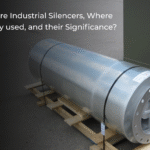In the bustling world of industrial operations, noise is more than just a byproduct — it’s a critical issue that affects health, safety, and operational efficiency. Industrial noise pollution is a significant issue in India that goes unaddressed. In some industrial zones, you can find noise levels surpassing 75 decibels during daytime and 70 decibels during nighttime time which are beyond the permissible sound levels of 50 dB and 40 dB during day and night.
Among the many solutions developed to manage noise pollution, industrial silencers play a pivotal role. These specialized devices are engineered to reduce the noise generated by equipment and machinery, ensuring compliance with environmental regulations while enhancing workplace safety and comfort. In this blog, you will learn about Industrial silencers and their effectiveness in curbing industrial noise pollution.
What are Industrial Silencers?
Industrial silencers, also known as industrial mufflers or noise suppressors, are devices designed to attenuate (reduce) the noise levels produced by industrial equipment. Unlike regular mufflers used in vehicles, industrial silencers must withstand extreme conditions such as high pressure, high temperatures, and corrosive environments.
These silencers operate based on various acoustic principles like absorption, reflection, and diffusion. The design and structure of an industrial silencer typically depend on the type of noise it aims to reduce — whether it’s generated by gas flow, mechanical vibrations, or pressure releases.
Industrial silencers are commonly made from materials like stainless steel or carbon steel, with internal baffles or chambers filled with sound-absorbing materials such as fiberglass or mineral wool.
Types of Industrial Silencers
Industrial silencers come in several types, tailored to specific applications:
1. Reactive Silencers: They are designed to control noise using geometric principles that involve reflecting and redirecting sound waves. They often have perforated chambers and tubes that cause sound waves to collide and reflect thereby effectively reducing overall noise level.
2. Absorptive Silencers: They use sound-absorbing materials to dampen high-frequency noise.
Each type is engineered for different noise profiles and operational conditions, making selection based on application crucial.
Where are Industrial Silencers Used?
Industrial silencers are ubiquitous in environments where machinery or processes produce high levels of sound. Common sectors include:
1. Power Plants
Turbines, boilers, and exhaust systems in thermal or gas-based power plants generate significant noise. Industrial silencers are used to reduce the sound of steam vents, safety relief valves, and exhaust stacks.
2. Manufacturing Units
CNC machines, compressors, and generators contribute to high ambient noise levels. Silencers are installed to maintain a safe working environment.
3. Oil and Gas Industry
In refineries and drilling sites, high-pressure gas release and flaring produce deafening noise. Vent and flare silencers help control this.
4. Chemical and Petrochemical Plants
Chemical processes often involve the use of pressurized gases. Silencers are used at release points to suppress noise while maintaining safety.
5. HVAC Systems
Large industrial air handling units and chillers can create excessive noise. Silencers in ducts and fans help reduce this in commercial buildings, hospitals, and data centers.
6. Marine and Locomotive Engines
Diesel-powered marine engines and trains use engine silencers to minimize noise pollution in and around ports and stations.
7. Aerospace and Defense Test cells for jet engines and missile launch facilities use advanced silencers to manage extreme sound levels.Significance of Industrial Silencers
The importance of industrial silencers goes far beyond mere noise reduction. Their impact spans several critical domains:
1. Workplace Safety and Health
Often referred to as a silent killer, prolonged exposure to high decibel levels can lead to hearing loss, stress, fatigue, and decreased concentration among workers. Industrial silencers help mitigate these health risks by maintaining noise levels within permissible exposure limits set by bodies like the Central Pollution Control Board of India.
2. Regulatory Compliance
Most countries have stringent regulations on industrial noise emissions. The use of silencers helps industries comply with environmental noise standards, avoiding legal penalties and shutdowns.
3. Operational Efficiency
Lower noise levels reduce fatigue among operators and increase communication clarity, leading to better workflow and fewer operational errors.
4. Community Relations
Industries located near residential areas often face backlash due to noise pollution. Areas like Mumbai’s MIDC, Delhi’s Okhla Industrial Area, Moradabad industrial hub, industrial areas in the Kolkata-Asansol region, and the Gurgaon-Delhi-Meerut region, and some industrial zones in Chennai are cited as locations with high noise pollution. Using industrial silencers helps maintain good relationships with neighboring communities and prevents potential conflicts or lawsuits.
5. Environmental Protection
In eco-sensitive zones, noise is considered a form of pollution. Silencers contribute to a greener industrial footprint, especially when used alongside emission control systems.
Wrapping Up:
Industrial silencers might not be the most visible component in an industrial setup, but their impact is profound. In an age where sustainable and responsible industrial practices are more important than ever, managing noise pollution is no longer optional — it’s essential.
From improving worker safety to enhancing operational efficiency and ensuring regulatory compliance, the role of industrial silencers is both strategic and indispensable. As an emerging global manufacturing hub, India is expected to see a significant rise in manufacturing industries in the coming years. With the industries continuously growing and technologies evolving, the demand for efficient and innovative noise control solutions like silencers will only increase, making them a silent but powerful ally in industrial progress.






